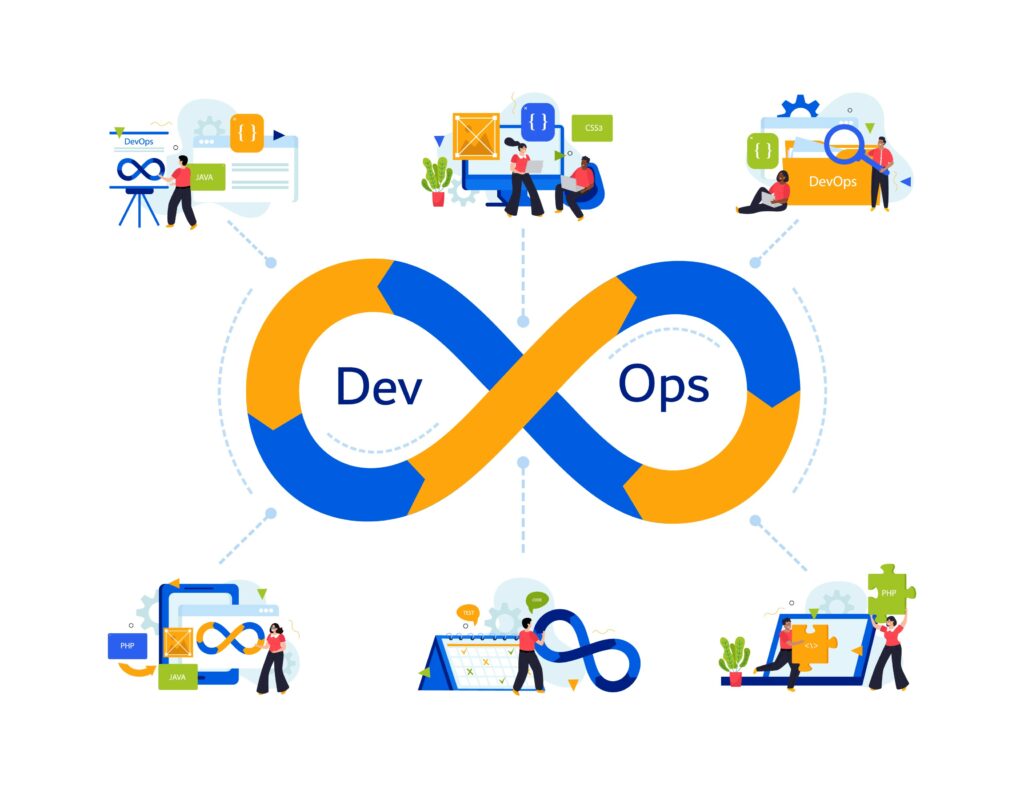DevSecOps, short for development, security, and operations, is an approach that emphasizes culture, automation, and platform design, ensuring security is a collective responsibility throughout the entire IT lifecycle.
What is DevOps?
DevOps revolves around three pillars: organizational culture, process, and technology/tools. These pillars aim to facilitate collaborative work between development and IT operations teams, enabling them to create, test, and release software more swiftly, agilely, and iteratively compared to conventional development processes.
The evolution of DevSecOps is a response to the imperative of consistently integrating security throughout the Software Development Life Cycle (SDLC). This ensures that DevOps teams can deliver secure applications with speed and quality.
By integrating testing, triage, and risk mitigation earlier in the Continuous Integration/Continuous Deployment (CI/CD) workflow, it prevents the time-consuming and often expensive consequences of addressing issues postproduction.
This concept aligns with “shifting left,” moving security testing towards developers. This empowers them to address security issues in their code almost in real time, rather than adding security as an afterthought at the end of the SDLC.
DevSecOps spans the entire SDLC, covering planning, design, coding, building, testing, and release, incorporating real-time continuous feedback loops and insights.

As per The DevOps Handbook, the DevOps ideal involves providing developers with rapid, continuous feedback on their work. This empowers them to swiftly and autonomously implement, integrate, and validate their code, leading to its deployment into the production environment. In simpler terms, DevOps aims to eliminate barriers between traditionally separated teams.
In a DevOps model, development and operations teams collaborate seamlessly throughout the entire software application life cycle, encompassing development, testing, deployment, and operations.
- What is DevSecOps?
- Why is DevSecOps so important?
- Software development lifecycle
- DevSecOps in the SDLC
- What is DevSecOps in Agile development?
- Skills in DevSecOps
- DevSecOps culture
What is DevSecOps?
DevSecOps is an abbreviation for development, security, and operations, and it serves as an extension of the DevOps methodology. Each component delineates distinct roles and responsibilities within software teams engaged in the development of software applications.
Development: It involves the comprehensive process of planning, coding, building, and testing the application.
Security: Integrating security measures at an earlier stage in the software development cycle. For instance, programmers ensure the code is devoid of security vulnerabilities, and security practitioners conduct additional testing before the software is released by the company.
Operations: These are the activities of releasing, monitoring, and resolving any issues that may arise from the software.
Why is DevSecOps so important?
DevSecOps strives to assist development teams in efficiently managing security concerns. It represents a contemporary alternative to outdated software security practices that struggled to adapt to tighter deadlines and swift software updates.
To appreciate the importance of DevSecOps, let’s take a brief look at the software development process.
Software development lifecycle
The software development lifecycle (SDLC) is a systematic process that directs software teams in creating top-notch applications. Utilizing the SDLC, software teams aim to cut costs, mitigate errors, and guarantee that the software consistently aligns with the project’s objectives.
The software development lifecycle navigates software teams through several key stages:
- Requirement analysis
- Planning
- Architectural design
- Software development
- Testing
- Deployment
DevSecOps in the SDLC
In traditional software development approaches, security testing operated independently from the Software Development Lifecycle (SDLC). Security flaws were typically identified by the security team after the software had been built.

The DevSecOps framework enhances the SDLC by proactively identifying vulnerabilities throughout the entire software development and delivery process. This integration ensures a more comprehensive and continuous approach to security, preventing the discovery of flaws only after the software has been constructed.
The functioning of DevSecOps involves a standard workflow:
- Software Development: The software is developed using a version control system.
- Code Analysis: Another team member scrutinizes the application for security weaknesses, evaluates overall code quality, and identifies potential bugs.
- Secure Deployment: The application is deployed with security configurations in place.
- Automation Testing: Automation is employed to test various aspects of the application, including its back end, user interface, integrations, and security features.
- Testing Approval: If the application successfully passes the automated tests, it proceeds to the production environment.
- Production Monitoring: In the production environment, multiple monitoring applications and security software continuously oversee and safeguard the application.
Implementing DevSecOps poses several challenges:
- People and Culture Shift:
– Retraining Teams: There is a need to retrain individuals within DevOps teams to comprehend security best practices and effectively operate new security tools.
– Cultural Adoption: Teams must adopt the mindset that they bear responsibility not only for the features, function, and usability of the software but also for its security throughout the development and deployment phases.
- Tooling Integration:
– Selecting and Integrating Tools: Finding the right security tools and seamlessly integrating them into the DevOps workflow is a significant challenge.
– Automation and Integration: The degree of automation in DevSecOps tooling and its integration with Continuous Integration/Continuous Deployment (CI/CD) pipelines directly impacts the level of training and cultural adaptation required.
- Adapting to Modern Environments:
– Open Source Challenges: As modern software applications heavily rely on open source software (around 70%), traditional security tools may struggle to accurately detect vulnerabilities in this context.
– Containerized Environments: Traditional security tools, even those labeled as “cloud security,” may not effectively assess the risks associated with applications running in dynamic containerized environments, where instances can rapidly spin up and down.
Navigating these challenges involves not only technological adjustments but also a substantial focus on training, cultural transformation, and aligning security practices with the evolving landscape of software development.
What is DevSecOps in Agile development?
In agile development, DevSecOps represents the integration of security practices into the iterative cycles of the agile framework.

Agile Development:
-Agile Mindset: Agile is a mindset fostering efficiency and adaptability within software teams as they build applications and respond to changes.
– Continuous Workflow: Unlike traditional methods with inflexible stages, agile involves a continuous circular workflow, enabling software teams to work in short, iterative development cycles.
– Constant Feedback: Agile processes emphasize gathering constant feedback to enhance applications and respond swiftly to evolving requirements.
DevSecOps in Agile Development:
– Non-Mutual Exclusivity: DevSecOps and agile are not mutually exclusive practices; they can complement each other.
– Quick Adaptation: Agile facilitates rapid response to change requests, while DevSecOps ensures the integration of security practices into each iterative cycle of agile development.
– Safer Code Production: Through DevSecOps, security becomes an integral part of agile development, allowing software teams to produce code that is not only agile but also inherently secure.
Skills in DevSecOps
DevSecOps engineers require a blend of technical expertise from development and IT, along with a solid understanding of the DevOps methodology. In addition, a profound knowledge of cybersecurity, encompassing the latest threats and trends, is crucial.
Key skills for DevSecOps engineers include:
- DevOps Principles and Culture:
Understanding: A clear comprehension of DevOps principles and culture is essential for effective integration.
- Programming Languages:
Knowledge: Proficiency in programming languages like Bash, Go, Python, and C is vital for executing DevSecOps tasks.
- Communication and Teamwork:
– Strong Skills: Effective communication and teamwork skills are crucial for collaborative efforts within DevSecOps teams.
- Risk Assessment and Threat Modeling:
– Understanding: Competence in risk assessment techniques and the ability to perform threat modeling contribute to proactive security measures.
- Cybersecurity Knowledge:
– Up-to-date Knowledge: Keeping abreast of the latest cybersecurity threats, software advancements, and best practices ensures a robust defense against emerging risks.
- DevOps and DevSecOps Tools:
– Familiarity: Proficiency in using DevOps and DevSecOps tools, such as Kubernetes, Ansible, Chef, Puppet, and Aqua, is necessary for streamlining processes and enhancing security.
These skills collectively empower DevSecOps engineers to navigate the intersection of development, IT operations, and cybersecurity. This will enable them to contribute effectively to the secure and efficient delivery of software applications.
DevSecOps culture
The DevSecOps culture is a holistic blend of communication, people, technology, and process, fostering a collaborative and security-focused approach throughout the software development lifecycle.
Communication:
– Cultural Change: Companies instill DevSecOps through a top-down cultural shift, with senior leaders emphasizing the significance and advantages of embracing security practices within the DevOps team.
– Empowerment: Software developers and operations teams are provided with the necessary tools, systems, and encouragement to integrate DevSecOps practices effectively.
People:
– Cultural Transformation: DevSecOps initiates a cultural transformation within software teams, breaking away from traditional roles. Software developers and operations teams collaborate closely with security experts to enhance security at every stage of the development process.
Technology:
– Automated Security Testing: Technology is leveraged for automated security testing during development, ensuring that security is maintained without compromising delivery timelines.
– Tools Usage: Examples include using tools like Amazon Inspector for automated continual vulnerability management at scale.
Process:
– Continuous Security Testing: DevSecOps alters the conventional software development process by incorporating security testing and evaluation at every stage.
– Proactive Security Measures: Developers identify and address security flaws during code writing. This is while security teams conduct pre-release assessments for vulnerabilities, covering aspects like authorization and input validation.
– Iterative Improvement: The operations team continues monitoring for potential issues even after the application goes live. Collaborating with security and development teams, they make amendments and release updated versions to ensure ongoing security.
It sets up a culture where security is not an afterthought but an integral part of the entire development and operations lifecycle. It will foster a proactive and collaborative approach to software security.
[Want to learn more on DevOps and DevSecOps? Click here to reach us.]
Conclusion
To sum up, DevSecOps integrates development, security, and operations for secure and efficient software delivery. Challenges include cultural shifts and adapting to modern environments. DevSecOps engineers need a mix of technical, cybersecurity, and communication skills.
The culture emphasizes collaboration, while technology automates security testing. In agile development, DevSecOps complements agility with inherent security. Overall, it ensures a proactive approach to security throughout the software development lifecycle. It is always better to have the hands of professional tech support teams such as Bobcares to learn and adapt more to the DevOps environment.
PREVENT YOUR SERVER FROM CRASHING!
Never again lose customers to poor server speed! Let us help you.
Our server experts will monitor & maintain your server 24/7 so that it remains lightning fast and secure.




0 Comments